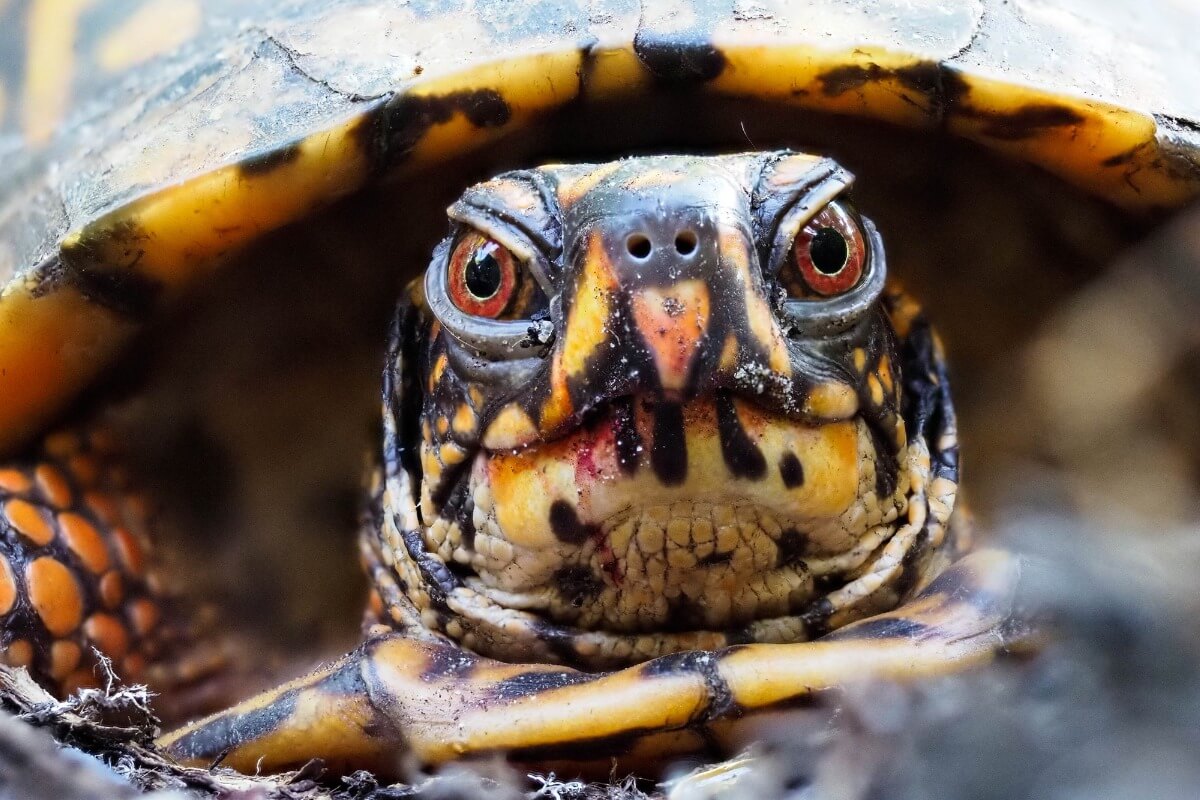Septicemia in Reptiles: Causes, Symptoms, and Treatment


Written and verified by the biologist Samuel Sanchez
Reptiles and amphibians are becoming increasingly common in homes, as an exotic pet in a naturalized terrarium provides a wealth of biological knowledge that can’t be obtained in other ways. Even so, there are certain illnesses that can endanger the life of your exotic animal in a matter of hours. Have you heard of septicemia in reptiles?
What is septicemia?
The term septicemia is thought to refer to the entry of bacteria into the body’s bloodstream, but this isn’t entirely true. When pathogenic microorganisms enter the bloodstream through prolonged infection, the isolated picture is called bacteremia.
Septicemia is the set of life-threatening physiological, pathological and biochemical abnormalities associated with bacteremia. These abnormalities result from an excessive immune response on the part of the affected animal, as the body tries to fight the blood-borne bacteria with everything it can. Septic shock is the most severe stage of this pathology.
Although they aren’t exactly analogous, in the veterinary clinic both terms are used interchangeably, because septicemia is still bacteremia with sepsis. In reptiles, the most commonly detected pathogens in septic disease are those belonging to the genera Aeromonas and Pseudomonas, although there are many more.
Septicemic cutaneous ulcerative disease (SCUD)
Septicemic cutaneous ulcerative disease is a specific variant of this condition that affects aquatic turtles. The causative agent is Citrobacter freundii, although other bacteria have also been isolated from lesions that emerge during the pathological course.
With SCUD, the turtle’s shell plates are pitted and may show an atypical purulent discharge. Abscesses and liver lesions are normal, but the typical septicemic condition isn’t usually linked to this disease.

Causes of septicemia in reptiles
As we’ve seen, septicemia is a condition caused by the entry of bacteria into the animal’s bloodstream. These are some of the most common causes:
- External injuries: A wound resulting from a blow, a burn, or an injury caused by a terrarium companion can cause bacteria to infiltrate beyond the epidermis. If the superficial infection is left untreated, the bacteria will enter the bloodstream and cause septicemia.
- Parasitic infestations: The presence of external parasites (mites) or internal parasites (nematodes and other “worms”) causes the animal’s immune system to weaken. This makes it easier for commensal or harmful bacteria to overcome the body’s biological barriers and reach the blood.
- Poor terrarium conditions: Too high or too low humidity, excessive temperature fluctuations, or an inadequate photoperiod in the terrarium will lead to immunosuppression of the animal.
All septicemic illnesses in reptiles derive from a very serious infection, but this can be propitiated by external factors such as stress, parasitosis or injuries. This makes it very important to see a veterinarian as soon as you notice a sign of illness in your pet.
Symptoms
The symptoms of septicemia in reptiles are systemic, i.e. they don’t occur in one area of the body. As the bacteria have spread through the bloodstream, most organs and devices will be affected to a greater or lesser extent. Some of the signs of this condition are as follows:
- Respiratory distress, which can manifest with rales and wheezing.
- Lethargy.
- Convulsions and spasms.
- Weakness or total inability to move.
- Loss of muscle control
- Discolored patches on some areas of the body, indicating a lack of oxygen.
Fluid accumulation, low body temperatures, and systematic refusal of food are also signs of septicemia in reptiles. If your pet is suffering from this condition it will look extremely ill, so don’t waste any time and go and see your vet.
Diagnosis
Diagnosis of septicemia is based on the animal’s symptoms and environmental parameters (diet, light, temperature, humidity, and dirt, among other things). Once the basic data have been collected by asking the owner, the vet will perform a general physical checkup of the pet.
The specific tests to be performed are coprological analysis (fecal cultures) and blood tests. This will detect bacteria in the blood and feces and confirm the diagnosis. Once the septicemia is confirmed, there’s no time to lose.
Treatment of septicemia in reptiles
Once septicemia is detected in the animal, systemic antibiotics will be prescribed immediately. These will probably be generic drugs, but you mustn’t wait until all the bacterial agents present in the blood are isolated and classified before beginning to treat it. In this scenario, every second counts.
Apart from antibiotics, the reptile will need to be hospitalized for supportive treatment, as it will most likely be too weak and dehydrated to carry out any biological functions. This includes intravenous fluid therapy, application of heat sources, and even oxygen supplementation.
Once at home, remember to give your pet the drug doses as prescribed by your veterinarian. Otherwise, the infection could become more potent.

Prognosis and prevention
Septicemia in reptiles usually ends well if acted upon in time, as most reptiles respond well to aggressive antibiotic treatment. However, the microorganisms may have caused irreversible damage to an organ and the pet may require special care in this case. Your vet will advise you on this.
The best way to prevent septicemia is always to keep the reptile’s environment clean, stable, suitable for its needs, and free of bacteria. If your pet still gets sick, go and see a vet before it’s too late.
Reptiles and amphibians are becoming increasingly common in homes, as an exotic pet in a naturalized terrarium provides a wealth of biological knowledge that can’t be obtained in other ways. Even so, there are certain illnesses that can endanger the life of your exotic animal in a matter of hours. Have you heard of septicemia in reptiles?
What is septicemia?
The term septicemia is thought to refer to the entry of bacteria into the body’s bloodstream, but this isn’t entirely true. When pathogenic microorganisms enter the bloodstream through prolonged infection, the isolated picture is called bacteremia.
Septicemia is the set of life-threatening physiological, pathological and biochemical abnormalities associated with bacteremia. These abnormalities result from an excessive immune response on the part of the affected animal, as the body tries to fight the blood-borne bacteria with everything it can. Septic shock is the most severe stage of this pathology.
Although they aren’t exactly analogous, in the veterinary clinic both terms are used interchangeably, because septicemia is still bacteremia with sepsis. In reptiles, the most commonly detected pathogens in septic disease are those belonging to the genera Aeromonas and Pseudomonas, although there are many more.
Septicemic cutaneous ulcerative disease (SCUD)
Septicemic cutaneous ulcerative disease is a specific variant of this condition that affects aquatic turtles. The causative agent is Citrobacter freundii, although other bacteria have also been isolated from lesions that emerge during the pathological course.
With SCUD, the turtle’s shell plates are pitted and may show an atypical purulent discharge. Abscesses and liver lesions are normal, but the typical septicemic condition isn’t usually linked to this disease.

Causes of septicemia in reptiles
As we’ve seen, septicemia is a condition caused by the entry of bacteria into the animal’s bloodstream. These are some of the most common causes:
- External injuries: A wound resulting from a blow, a burn, or an injury caused by a terrarium companion can cause bacteria to infiltrate beyond the epidermis. If the superficial infection is left untreated, the bacteria will enter the bloodstream and cause septicemia.
- Parasitic infestations: The presence of external parasites (mites) or internal parasites (nematodes and other “worms”) causes the animal’s immune system to weaken. This makes it easier for commensal or harmful bacteria to overcome the body’s biological barriers and reach the blood.
- Poor terrarium conditions: Too high or too low humidity, excessive temperature fluctuations, or an inadequate photoperiod in the terrarium will lead to immunosuppression of the animal.
All septicemic illnesses in reptiles derive from a very serious infection, but this can be propitiated by external factors such as stress, parasitosis or injuries. This makes it very important to see a veterinarian as soon as you notice a sign of illness in your pet.
Symptoms
The symptoms of septicemia in reptiles are systemic, i.e. they don’t occur in one area of the body. As the bacteria have spread through the bloodstream, most organs and devices will be affected to a greater or lesser extent. Some of the signs of this condition are as follows:
- Respiratory distress, which can manifest with rales and wheezing.
- Lethargy.
- Convulsions and spasms.
- Weakness or total inability to move.
- Loss of muscle control
- Discolored patches on some areas of the body, indicating a lack of oxygen.
Fluid accumulation, low body temperatures, and systematic refusal of food are also signs of septicemia in reptiles. If your pet is suffering from this condition it will look extremely ill, so don’t waste any time and go and see your vet.
Diagnosis
Diagnosis of septicemia is based on the animal’s symptoms and environmental parameters (diet, light, temperature, humidity, and dirt, among other things). Once the basic data have been collected by asking the owner, the vet will perform a general physical checkup of the pet.
The specific tests to be performed are coprological analysis (fecal cultures) and blood tests. This will detect bacteria in the blood and feces and confirm the diagnosis. Once the septicemia is confirmed, there’s no time to lose.
Treatment of septicemia in reptiles
Once septicemia is detected in the animal, systemic antibiotics will be prescribed immediately. These will probably be generic drugs, but you mustn’t wait until all the bacterial agents present in the blood are isolated and classified before beginning to treat it. In this scenario, every second counts.
Apart from antibiotics, the reptile will need to be hospitalized for supportive treatment, as it will most likely be too weak and dehydrated to carry out any biological functions. This includes intravenous fluid therapy, application of heat sources, and even oxygen supplementation.
Once at home, remember to give your pet the drug doses as prescribed by your veterinarian. Otherwise, the infection could become more potent.

Prognosis and prevention
Septicemia in reptiles usually ends well if acted upon in time, as most reptiles respond well to aggressive antibiotic treatment. However, the microorganisms may have caused irreversible damage to an organ and the pet may require special care in this case. Your vet will advise you on this.
The best way to prevent septicemia is always to keep the reptile’s environment clean, stable, suitable for its needs, and free of bacteria. If your pet still gets sick, go and see a vet before it’s too late.
All cited sources were thoroughly reviewed by our team to ensure their quality, reliability, currency, and validity. The bibliography of this article was considered reliable and of academic or scientific accuracy.
- Common diseases in pet snakes, VCA Hospitals. Recogido a 3 de noviembre en https://vcahospitals.com/know-your-pet/snakes-diseases
- Septicemia in lizards, Wag! Recogido a 3 de noviembre en https://wagwalking.com/reptile/condition/septicemia-in-lizards
- Bacterial diseases of reptiles, MSD Manuals. Recogido a 3 de noviembre en https://www.msdvetmanual.com/exotic-and-laboratory-animals/reptiles/bacterial-diseases-of-reptiles
This text is provided for informational purposes only and does not replace consultation with a professional. If in doubt, consult your specialist.








